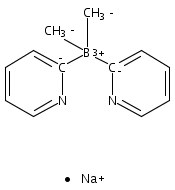Rhodium(I) and Iridium(I) borate complexes of the structure [Me2B(2-py)2]ML2 (L2 = (tBuNC)2, (CO)2, (C2H4)2, cod, dppe) were prepared and structurally characterized (cod = 1,5-cyclooctadiene; dppe = 1,2-diphenylphosphinoethane). Each contains a boat-configured chelate ring that participates in a boat-to-boat ring flip. Computational evidence shows that the ring flip proceeds through a transition state that is near planarity about the chelate ring.We observe an empirical, quantitative correlation between the barrier of this ring flip and the π acceptor ability of the ancillary ligand groups on the metal. The ring flip barrier correlates weakly to the Tolman and Lever ligand parameterization schemes, apparently because these combine both σ and π effects while we propose that the ring flip barrier is dominated by π bonding. This observation is consistent with metal–ligand π interactions becoming temporarily available only in the near-planar transition state of the chelate ring flip and not the boat-configured ground state. Thus, this is a first-of-class observation of metal–ligand π bonding governing conformational dynamics.Graphical abstractRhodium(I) and Iridium(I) borate complexes [Me2B(2-py)2]ML2 (L2 = (tBuNC)2, (CO)2, (C2H4)2, cod, dppe) have a boat-configured chelate ring that participates in a boat-to-boat ring flip. The barrier of this ring flip is correlated to the π acceptor ability of the ancillary ligand groups on the metal.
![Image for unlabelled figure]()
